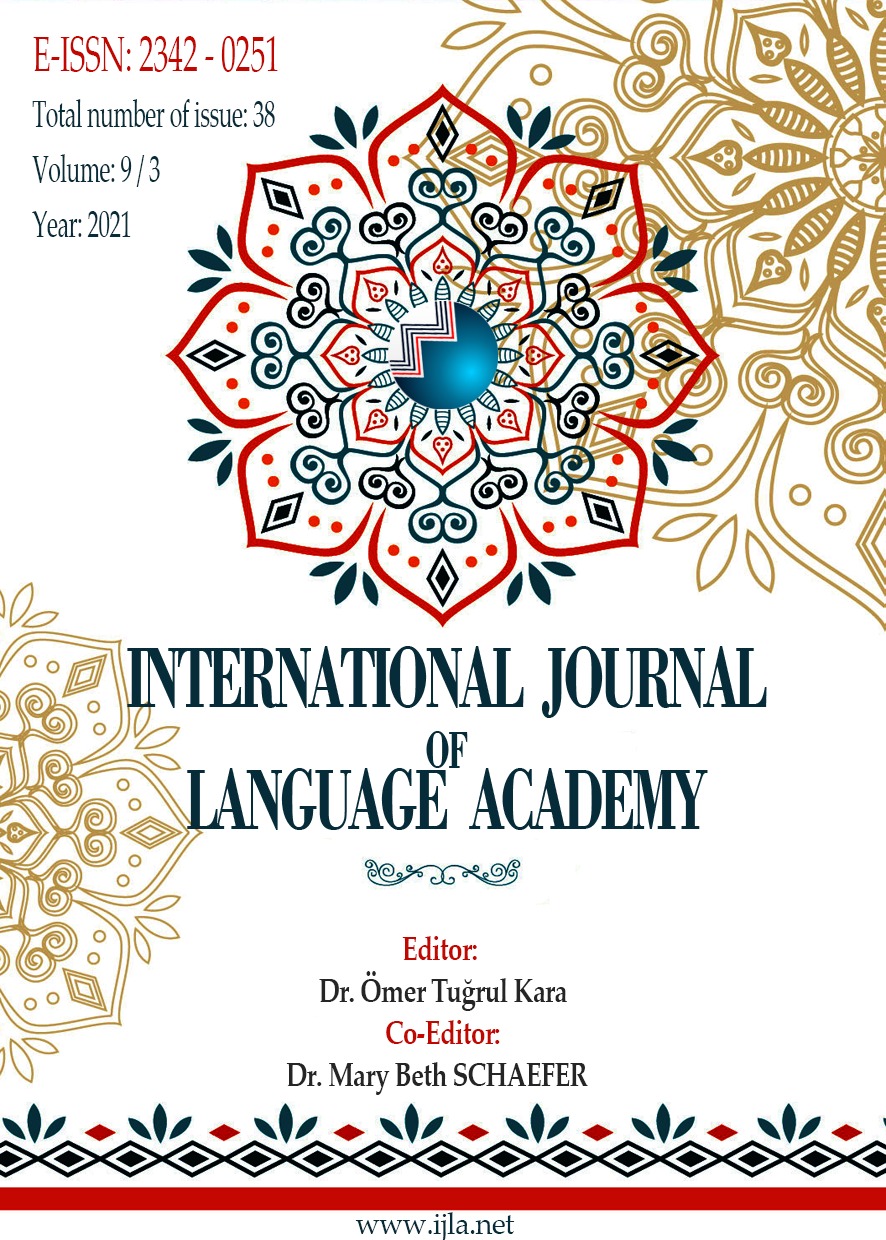THE EFFECTS OF FLIPPED SPEAKING LESSONS ON STUDENTS’ ENGLISH SPEAKING ANXIETY: THE CASE OF 5TH GRADE STUDENTS
Author :
Abstract
Keywords
Abstract
Flipped learning is a new pedagogical trend in which traditional teacher-led classrooms are transformed into student-centered and individual-based learning environments. The main rationale behind the flipped instruction is to create a more dynamic and interactive classrooms where teachers serve as a guide and facilitator. This study attempts to integrate a flipped learning environment into an English speaking class in which most of the students are observed to have English speaking anxiety prior to the flipped learning treatment process. The aim of the study is to investigate the role of flipped learning on reducing Turkish EFL students’ speaking anxiety. To this end, twenty seven 5thgrade students in a state school have been instructed through flipped learning model to practice speaking skill for ten weeks. The study employed a mixed-method research design in which quantitative data were collected via a speaking anxiety scale and qualitative data were obtained through semi-structured interview. The scale was administered to the students before and after the flipped class treatment and their stated responses were compared and contrasted together with the findings of the interviews to get an in-depth idea about the effectiveness of the treatment process. The results of t-test and semi-structured interviews revealed that the participants’ speaking anxiety was reduced remarkably in general after the treatment process. However, it was also found that some problems derived from students’ psychological load regarding shyness and the lack of self-confidence during speaking practice still affect their oral production in the target language in a negative way.
Keywords
- Abdullah, M. Y., Hussin, S., &Ismail, K. (2019). Implementation of flipped classroom model and its effectiveness on English speaking performance. IJET, 14(9), 130
- Ahmed, S. (2016). The Flipped Classroom Model to Develop Egyptian EFL students’ listening comprehension. English Language Teaching, 9(9), 166-178.
- Amiryousefi, M. (2017). The incorporation of flipped learning into conventional classes to enhance EFL learners‘ L2 speaking, L2 listening, and engagement. Innovation in Language Learning and Teaching, 1–15.doi:10.1080/17501229.2017.1394307
- Anderson, D. (2012). The flipped classroom for EFL. Retrieved June 24, 2021 from http://photos.state.gov/libraries/thailand/591452/relo/030612_english_roundt abl e.pdf
- Anderson, L. W., Kratkwohl, D. R., & Bloom , B. S. (2001). A taxonomy for learning, teaching, and assessing: A revision of Bloom's taxonomy of educational objectives. Boston, MA: Allyn & Bacon.
- Bergman, J. & Sams, A. (2012). Flip your classroom: Reach every student in every class every day, USA: Iste. ASCD.
- Baepler, P., Walker, J. D., & Driessen, M. (2014). It’s not about seat time: Blending, flipping, and efficiency in active learning classrooms. Computers & Education, 78, 227–236. doi:10.1016/j.compedu.2014.06.006
- Berrett, D. (2012). How ‘flipping’ the classroom can improve the traditional lecture. The Education Digest, 78(1), 36.
- Cheng, Y. (2001). Learners’ beliefs and second language anxiety concentric, Studies in English Literature and Linguistics, 27(2), 75-90.
- Creswell, J. W., & Clark, V. L. P. (2017). Designing and conducting mixed methods research. London: Sage publications.
- Çağatay, S., (2015). Examining EFL students’ foreign language speaking anxiety: The case at a Turkish state university. Procedia-Social and Behavioral Sciences, 199: 648-656. Available at: https://doi.org/10.1016/j.sbspro.2015.07.594.
- Educause. (2012). 7 things you should know about flipped classrooms. Retrieved from: http://net.educause.edu/ir/library/pdf/ELI7081.pdf
- Ekmekci, E. (2014). Flipped Writing Class Model with a Focus on Blended Learning. Unpublished PhD Dissertation. Gazi University Graduate School of Educational Sciences, Ankara.
- Folse, K. S. (2006). The art of teaching speaking: Research and pedagogy for the ESL/EFL classroom. Ann Arbor: University of Michigan.
- Horwitz, E.K. (1986). 'Preliminary Evidence for the Reliability and Validity of a Foreign Language Anxiety Scale', in E.K. Horwitz and D.J. Young (eds.), Language Anxiety: From Theory to Research to Classroom Practices (New York: Prentice Hall).
- Kojima, E., (2007). Factors associated with second language anxiety from different cultural backgrounds (Doctoral Dissertation). Retrieved from ProQuest dissertations & Theses Database. (UMI No 3278371).
- Kong, S. C. (2014). Developing information literacy and critical thinking skills through domain knowledge learning in digital classrooms: an experience of practicing flipped classroom strategy. Computers and Education, 78, 160–173.
- Li, S. (2016). A study of learners’ satisfaction towards college oral English flipped classroom. Theory and Practice in Language Studies, 6(10), 1958-1963.
- Mahmoodzadeh, M., (2012). Investigating foreign language speaking anxiety within the EFL learners' interlanguage system: The case of Iranian learners. Journal of Language Teaching and Research, 3(3): 466-476. Available at: http://dx.doi.org/10.4304/jltr.3.3.466-476.
- Orakcı,Ş. (2018). A Validity and Reliability Study of “English Speaking Anxiety Scale.” İnönü Üniversitesi Eğitim Bilimleri Enstitüsü Dergisi, April, 1–18. https://doi.org/10.29129/inujgse.375916
- Ortega, L., (2009). Understanding second language acquisition. New York: Routledge.
- Öztürk, G., & Gürbüz, N. (2012). The impact of gender on foreign language speaking anxiety and motivation. Procedia - Social and Behavioral Sciences, 70, 654 – 665.
- Siplakides, I. & Keramida, A. (2009). Helping Students Overcome Foreign Language Speaking Anxiety in the English Classroom: Theoretical Issues and Practical Recommendations. International Educational Studies, 2(4), 39-44.
- Strayer, J. F. (2012). How learning in an inverted classroom influences cooperation, innovation and task orientation. Learning Environments Research, 15(2), 171– 193. doi: 10.1007/s10984-012-9108-4
- Ushioda, E. (2011). “Language Learning Motivation, Self and Identity: Current Theoretical Perspectives.” Computer Assisted Language Learning, 24(3): 199–210.
- Vaughan, M. (2014). Flipping the learning: An investigation into the use of the flipped classroom model in an introductory teaching course. Education Research & Perspectives, 41, 25-41.
- Walvoord, B. E., & Anderson, V. J. (2011). Effective grading: A tool for learning and assessment in college. San Francisco: Wiley
- Zhang, P., Ma, J., & Liu, Y. (2014). Flipped classroom: An effective model of improving student teachersʹ educational technology. Journal of Information Technology & Application in Education, 3(3), 144-149. http://dx.doi.org/ 10.14355/jitae.2014.0303.02
- Woodrow, L. (2006). “Anxiety and Speaking English as a Second Language.” RELC Journal 37(3):308–28. doi: 10.1177/0033688206071315.
